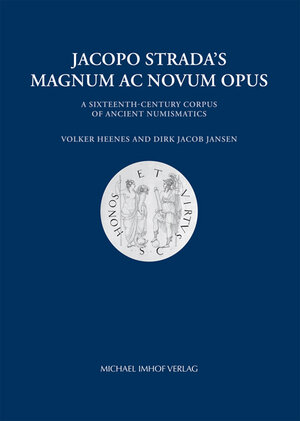Jacopo Strada’s Magnum Ac Novum Opus
A Sixteenth-Century Corpus of Ancient Numismatics
von Volker Heenes und Dirk Jacob JansenFrom about 1550 onward, the Mantuan antiquary and architect Jacopo Strada (1515–1588) created a thirty-volume corpus for the Augsburg banker and politician Hans Jakob Fugger (1516–1575), depicting coins of the Roman Empire from Gaius Julius Caesar to Charles V: the Magnum ac Novum Opus. Now preserved in the Forschungsbibliothek Gotha, it contains almost nine thousand drawings of Roman Imperial coins. Strada also created an eleven-volume coin catalogue, A. A. A. NumismatΩn Antiquorum ΔΙΑΣΚΕΥΕ, manuscripts of which are preserved in Vienna and in Prague, which contains coin descriptions that, Strada claimed, complemented the Magnum ac Novum Opus.
In a project funded by the Deutsche Forschungsgemeinschaft DFG, images and texts have been combined for the first time. For this purpose, Strada’s drawings and descriptions of coins of the Roman emperors from Caesar to Trajan have been entered into the databases of the Census of Antique Works of Art and Architecture Known in the Renaissance (Humboldt Universität zu Berlin) and of Translatio Nummorum (Kunsthistorisches Institut, Florence). In addition, the two works have been studied in their mutual relationship, and have been placed in their antiquarian-numismatic and art historical context. The first results of this combination of diverse scholarly approaches are published in the present volume. They reveal numerous new aspects and perspectives of antiquarian scholarship during the second half of the sixteenth century, and thus represent an important contribution to the history of antiquarian studies, in particular of early numismatics.
In a project funded by the Deutsche Forschungsgemeinschaft DFG, images and texts have been combined for the first time. For this purpose, Strada’s drawings and descriptions of coins of the Roman emperors from Caesar to Trajan have been entered into the databases of the Census of Antique Works of Art and Architecture Known in the Renaissance (Humboldt Universität zu Berlin) and of Translatio Nummorum (Kunsthistorisches Institut, Florence). In addition, the two works have been studied in their mutual relationship, and have been placed in their antiquarian-numismatic and art historical context. The first results of this combination of diverse scholarly approaches are published in the present volume. They reveal numerous new aspects and perspectives of antiquarian scholarship during the second half of the sixteenth century, and thus represent an important contribution to the history of antiquarian studies, in particular of early numismatics.







